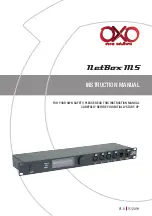
User Manual
Z-SG2 / Z-SG2-L
ALL RIGHTS RESERVED. NO PART OF THIS PUBLICATION MAY
BE REPRODUCED WITHOUT PRIOR PERMISSION.
www.seneca.it
Doc: MI-005370-EN
Rev. 6
Page 11
LOAD CELL CONNECTION
5.
It is possible to connect the converter to the load cell in 4- or 6-wire mode. 6-wire measurement is preferable
for measurement accuracy.
The load cell power supply is provided directly by Z-SG2.
4 OR 6-WIRE LOAD CELL CONNECTION
5.1.
A load cell can have a four-wire or six-wire cable. In addition to having the +/- excitation and +/- signal lines a
six-wire cable also has the +/- sense lines. It is a common misconception to think that the only difference
between 4- or 6-wire load cells is the possibility of the latter to measure the actual voltage at the load cell. A
load cell is compensated to work within specifications in a certain temperature range (usually -10 - +40°C).
Since the cable resistance depends on the temperature, the response of the cable to temperature changes
must be eliminated. The 4-wire cable is part of the load cell temperature compensation system. The 4-wire
load cell is calibrated and compensated with a certain amount of cable connected. For this reason, never cut
the cable of a 4-wire load cell. The cable of a 6-wire cell, on the other hand, is not part of the load cell
temperature compensation system. The sense lines are connected to the sense terminals of the
indicator/meter, to measure and adjust the actual voltage of the load cell. The indicator/meter corrects the
output voltage or its amplifier to compensate for the change in resistance in the cable. The advantage of using
this "active" system is the possibility of cutting (or extending) the 6-wire load cell cable to any length. It must be
considered that a 6-wire load cell will not reach the performance declared in the specifications if the sense
lines are not used.
The figures show the two possible connections:












































